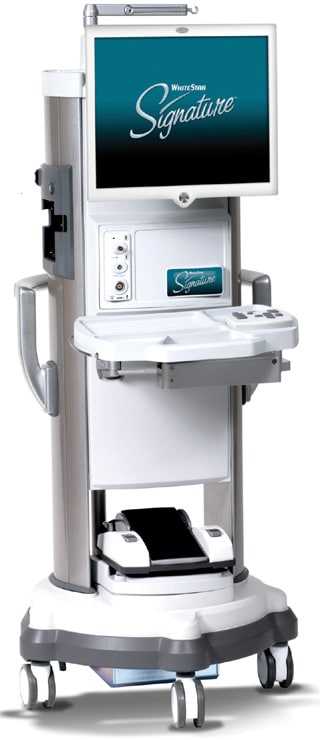Spotlight ON TECHNOLOGY & TECHNIQUE
A Phaco System That Increases Chamber Stability and Reduces Post-Occlusion Surge
By Leslie Goldberg, Associate Editor
Advanced Medical Optics' WhiteStar Signature phacoemulsification system combines AMO's (Santa Ana, Calif.) WhiteStar technology with its fusion dual-pump fluidic system to improve chamber stability and reduce post-occlusion surge.
WhiteStar technology reduces the amount of phaco energy directed into the eye while providing full ultrasound cutting efficiency. "Nuclear fragments are drawn safely and efficiently to the phaco tip, resulting in visibly clearer corneas 1day postop without changing technique," says Becky Cope, marketing director of global cataract equipment with Advanced Medical Optics. Several of the Signature's newest features will be revealed at the American Academy of Ophthalmology meeting to be held in New Orleans in November.
Signature Features and Benefits
"I have been using the AMO Sovereign system for many years," says David Chang, M.D., clinical professor of ophthalmology at the University of California, San Francisco. "The AMO Signature system retains key Sovereign innovations, such as the WhiteStar hyperpulse phaco modulation, which dramatically reduces phaco energy and heat delivery while reducing particulate turbulence within the anterior chamber."
The Signature will also come with an updated phaco tip function, which should further reduce chatter by decreasing the repelling force of longitudinal phaco strokes, says Dr. Chang.
The Signature will also introduce a unique new dual-pump fluidic system that can function either as a live vacuum Venturi pump or a traditional peristaltic pump, says Dr. Chang.
"What is exciting is that this dual capability is accomplished with a single pump and a single type of tubing cassette," says Dr. Chang. "This means that the surgeon can use the foot pedal to switch back and forth between the two pump functions during the same operation."
Depending upon the stage of the case, surgeons should be able to alternate the speed and efficiency of a Venturi pump with the safety of a peristaltic flow-based pump, says Dr. Chang.
"For instance, a Venturi pump function can be used for chopping and mobilizing nuclear segments before switching to the peristaltic pump function for aspirating the final nuclear fragments," he says.
Dr. Chang says that the ability of the Venturi pump to draw material to the tip without full occlusion will be advantageous for aspirating the epinucleus and cortex.
The Signature also has an Intellesis sensor, a device that literally connects the system to the eye. Just as the ear contains a tympanic membrane that responds to sound waves, the Intellesis sensor incorporates an aspiration-line diaphragm that moves in precise synchronization with vacuum pressure variations at the tip.

Increased Safety
"The WhiteStar Signature system is a truly unique lens extraction platform, designed to optimize the safety of the intraocular environment and improve the efficiency of the operating room," says Cope.
"An important safety feature of Fusion Fluidics is what I call an 'anti-surge algorithm'" says Dr. Chang. "High vacuum helps us to grip and draw in a nuclear fragment, but to avoid post-occlusion surge we would prefer a much lower vacuum level at the moment that tip occlusion breaks."
The anti-surge algorithm tries to automate this by reducing the vacuum in anticipation of the occlusion break. Dr. Chang can program his foot pedal to allow him to turn the anti-surge algorithm on or off during the case, depending upon whether he needs better chamber stability.
"Like activating ABS brakes on a car, this algorithm automatically drops the vacuum level down after a pre-determined interval to prevent surge as I am aspirating nuclear fragments," concludes Dr. Chang.
| The AMO Signature system retains key Sovereign innovations, says David Chang, M.D. |
AMO currently employs the upgraded safety features of advanced pulse shaping and Chamber Automated Stabilization Environment (CASE), which is truly revolutionary, says the company. Prior to CASE, power modulations or occlusion modes regulated the rising portion of the vacuum curve.
CASE now makes it possible to regulate the descending curve, which is where surgeons experience the main problems with surge. With CASE and the settings in the new Signature system, the surgeon can operate at high vacuum levels for a distinct, pre-set period of time. OM
For more information on AMO's WhiteStar Signature phacoemulsification system, visit AMO's Web site at www.sovereignsystem.com.
Dr. Chang is a consultant for Advanced Medical Optics, Alcon Laboratories and Visiogen.








